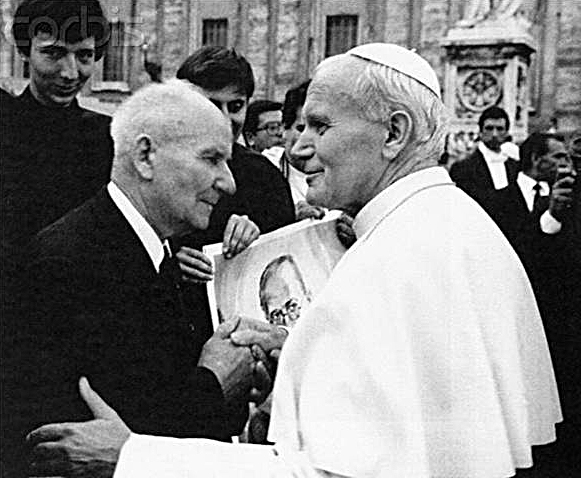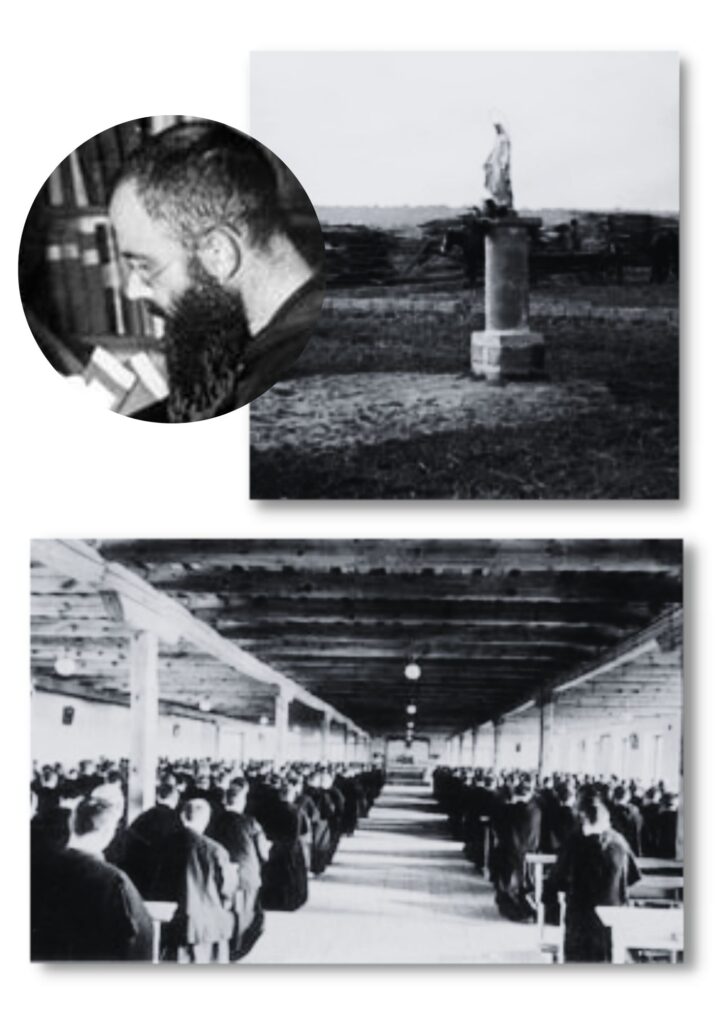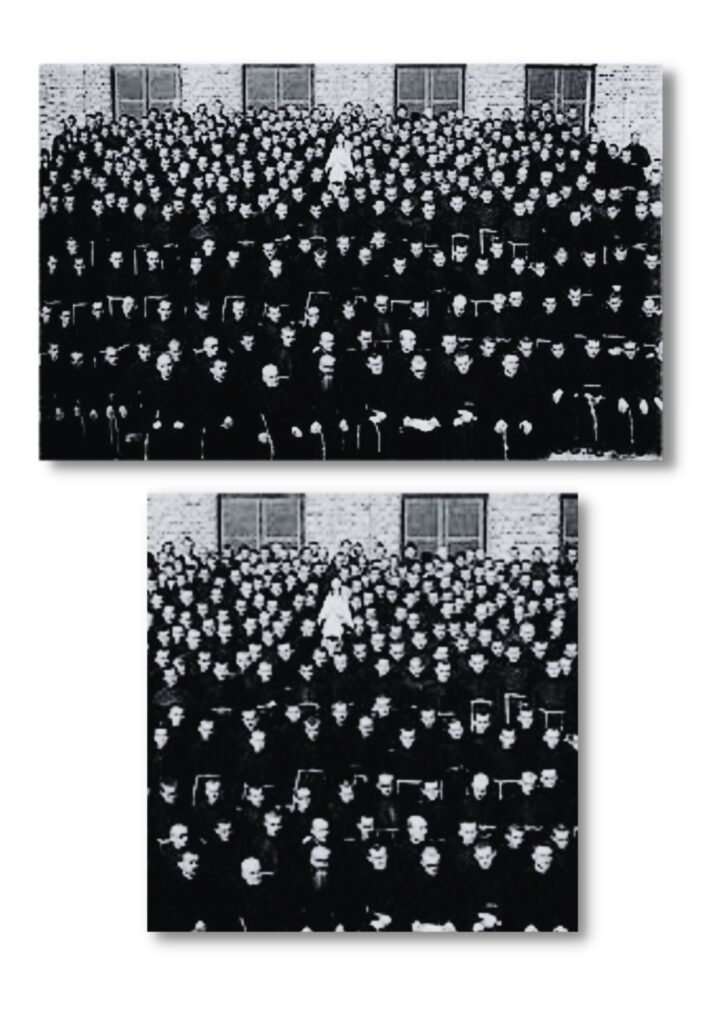Table of content
- Year 1917
- The development of the M.I.
- The MI betrayed after the Second Vatican Council
1. Year 1917
The year of the October Revolution in Russia, but also the year of the apparitions of Our Lady at Fatima.
In addition, at Rome, the Freemasonry celebrated the two-hundred-years anniversary of its establishment. Everywhere they spread flags and images representing the Archangel St. Michael defeated and overthrown by Lucifer. The parades filled the streets of the Eternal City. And in the square of St. Peter, one heard blasphemous slogan like: « Satan will reign over the Vatican and the pope will be his servant. »
Brother Maximilian Mary Kolbe, a Polish Franciscan friar, was then a student of theology at the Gregorianum in Rome and became thus an unwilling witness at these disturbing demonstrations. He asked himself this question:
« Is it possible that our enemies carry out such an activity to dominate us while we stay idle, at most spending time in prayer, but without taking any action? Don’t we have weapons that are even more powerful, and can we not count on Heaven and especially on the Immaculata? »
In meditating on the Holy Scriptures and the writings of the Fathers of the Church, inspiring himself with the doctrines of the great Marian saints like S. Louis-Marie Grignion de Montfort, and also pondering on the dogma of the Immaculate Conception and the apparitions of the Our Lady at Lourdes, without forgetting the practical and social application of these great truths, the young brother came to the following conclusion:
« The Immaculate Virgin, victorious over all heresies, will not give way to Her enemy who turns himself against Her. As long as She will find servants that are faithful and docile to Her commandment, She will carry on new victories, much grander than we could ever imagine. »
In 1917, Rome celebrated also another anniversary, that of a victory for the Immaculata: the wonderful conversion of Alphonsus Ratisbonne, a Jew, which had taken place in 1842. This conversion had been obtained through the graces of the Miraculous Medal.
This happy coincidence gave to brother Maximilian the idea of a knighthood of the Immaculata. Its symbol would be the Miraculous Medal.
Thus, three days after the miracle of the sun at Fatima, on October 16th, 1917, with the permission of his superior and kneeling before the altar of Our Lady in the chapel of the Seraphic College at Rome, Father Maximilian founded with six brothers the Militia Immaculatæ.
2. The development of the M.I.
From the year following its foundation, the Militia Immaculatæ received the apostolic blessing of Pope Benedict XV, a blessing renewed many times by his successors.
It was later approved as a « Pious Association » under Pius XI, on January 2nd, 1922, then elevated to a « Pia Unio Primaria » in 1927, which allowed Father Maximilian to open other houses. From then, the M.I. underwent a huge expansion throughout the whole world, extending even to the Far East.
In 1933, only six years after the foundation of the City of the Immaculata (Niepokalanów), the Motherhouse counted 762 religious working with zeal in any kind of apostolate, and in particular that of the printing press which was the main monthly publication.
In 1939 the magazine “Knights of the Immaculata” was published up to 750 000 copies.
In 1942, for the 25th anniversary of the founding of the Militia Immaculata, the Association received a new approbation from Pope Pius XII, with his compliments and his apostolic blessings.
By the time of the Second Vatican Council, the M.I. numbered 500 houses on the five continents and around 3 million members.
The MI betrayed after the Second Vatican Council

The revolution inspired by the Second Vatican Council did not spare the M.I. and introduced some radical changes there.
1. THE NAME
The detractors of the Militia Immaculatæ and of all that refers to the Virgin Mary launched the attack first of all on the name « Militia Immaculatæ » and changed it to « Mission of the Immaculata » thus removing the militant, defensive and victorious character of the Immaculata which did not correspond to the false principles of the religious liberty and conciliar pacifism.
Quickly after this, the statutes were also adapted to the spirit of the Council. Alas the new statutes were not filled with quotes of the saints but of the Second Vatican Council, and of Popes Paul VI and John Paul II. Only three little quotes of the writings of St. Maximilian-Mary Kolbe were left in it.
2. THE GOAL
These modified statutes give an entirely new objective for the MI. There is no longer mention of the Freemasons, the heretics etc.
The daily prayer of the knights « O Mary conceived without sin » was also modified. In fact, under divine inspiration Fr. Maximilian had added « and for those who do not have recourse to thee, especially for the Freemasons ». This last part of the prayer was removed.
The conversion of souls, the abandon of error and the return to the bosom of the Church no longer appear in these statutes. Not a single word about the devil as the principal enemy of the Immaculata and of souls. In consequence, no allusion to the salvation of souls, which it is necessary at all costs to drag away from Hell.
3. THE ESSENCE
If one still speaks about the total consecration to the Immaculata, the concrete implications of this consecration are essentially changed. Not a word of obedience to the will of the Immaculata. In place of the apostolate to propagate the true faith, one now insists on activities created to promote the human dignity and to protect human life.
The Most Holy Mother of God is presented as though She was one example among others to imitate and not as the sure means of sanctification and our only Hope to reach holiness.
On the other hand, the new statutes are completely silent on what Father Maximilian calls « the practical application of the dogma of the Immaculate Conception ». That is to say, Her active role as Mediatrix of all graces in particular the graces of conversion and sanctification (a truth which since Vatican II, has been reduced to an opinion for debate). Thus, what the founder considered as the founding pillar of his project is denied:
« All the works of the M.I. are based on the truth that Mary is the Mediatrix of all graces. If it was not so, then all our works and our efforts would be worthless. » (Conference, 6 June 1933)













